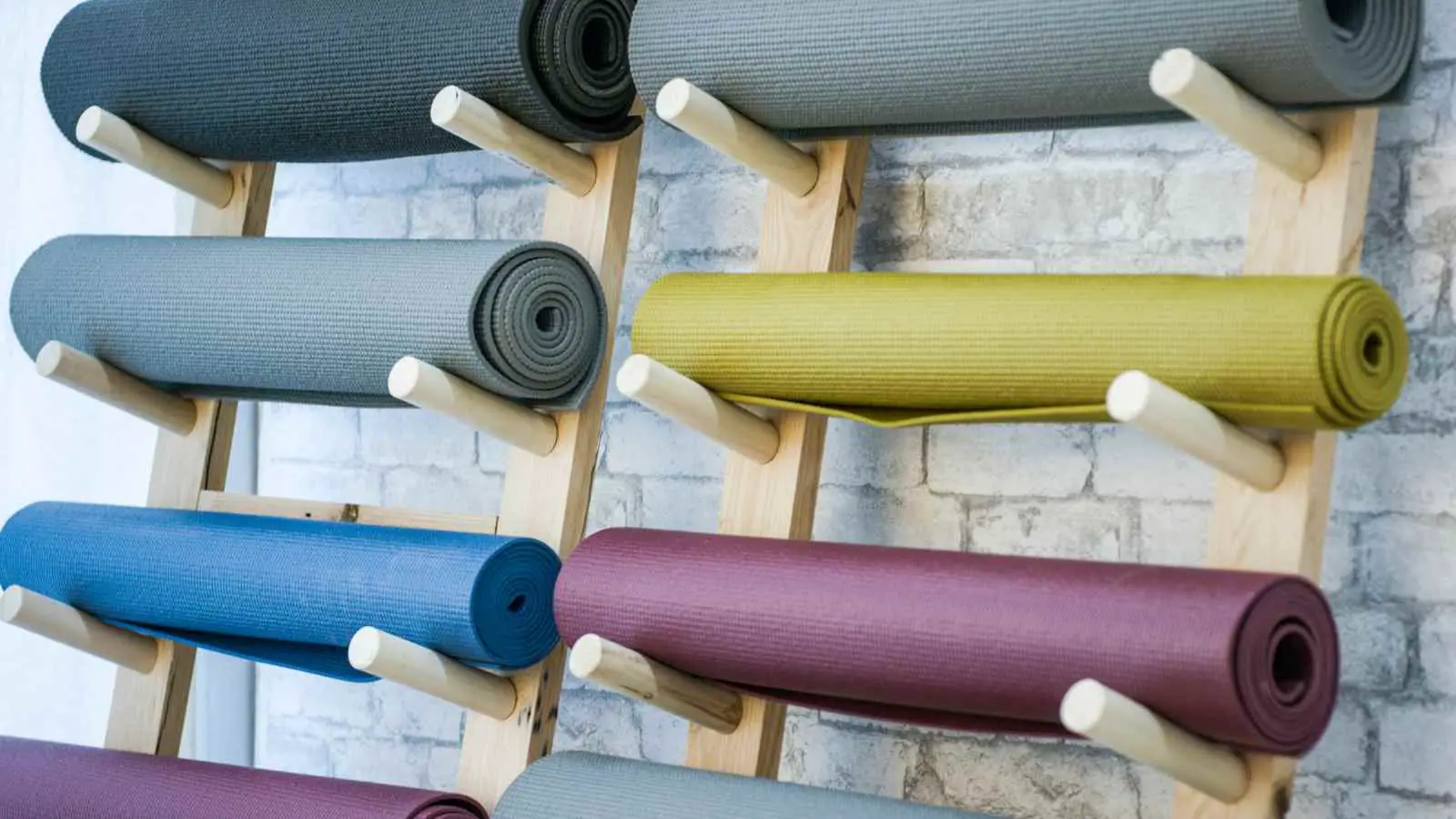In the world of yoga, the mat is more than just an accessory – it’s the sacred space where mind, body, and spirit connect. As more and more people embrace yoga, there’s a growing awareness about the impact of yoga mats on the environment. While there are many types of yoga mats available in the market, PVC (polyvinyl chloride) mats have been a popular choice due to their affordability and durability. However, despite their widespread use, PVC yoga mats have been under scrutiny due to their environmental impact.
In this article, I will delve into why PVC yoga mats are considered less eco-friendly and explore some greener alternatives. But before diving deeper, let’s quickly cover what is PVC?
What is PVC?
PVC, short for polyvinyl chloride, is one of the most widely used types of plastic in the world. You likely encounter PVC every day in various forms, from the pipes in your home’s plumbing system to the insulation on electrical cables, and yes, even to the yoga mat you might be using for your daily practice.
PVC is a synthetic plastic polymer, which means it’s a type of plastic made by linking together many smaller molecules known as monomers. In the case of PVC, these monomers are derived from vinyl chloride, a type of gas that is itself produced from petroleum or natural gas and chlorine.
The reason PVC is so widely used is that it has several appealing properties. It’s highly durable, resistant to weathering, and versatile. It can be made rigid or flexible depending on the manufacturing process and additives used, which makes it suitable for a broad range of applications.
In the context of yoga mats, PVC is often favoured because it’s sticky, soft, and durable, providing a comfortable and secure surface for yoga practice. However, as you will read further in this article, the environmental and health impacts of PVC use are significant, leading many to seek out alternative materials for their yoga mats.
It’s important to note that while PVC has been a popular material for yoga mats, many manufacturers and consumers are now moving towards more eco-friendly and health-conscious options, such as mats made from natural rubber, cork, or jute. These materials offer many of the same benefits as PVC without the associated environmental and health concerns. More about this a little later.
Why PVC is not a good choice for yoga?
Now that we’ve shed light on what PVC is, let’s look at the reasons why this plastic mat might not be the best choice for you as a yogi or even for yoga studios and shops considering their merchandise options.
PVC is Non-Biodegradable
For those readers (for example, young yogis) who do not know what ‘Non-Biodegradable’ mean, I would like to explain. Non-Biodegradable refers to materials that cannot be broken down naturally by living organisms, such as bacteria or fungi, into simpler, harmless substances. PVC (polyvinyl chloride), the material commonly used in traditional yoga mats, falls into this category. PVC is a type of plastic that does not break down naturally in the environment.
When a PVC yoga mat is discarded, it doesn’t readily decompose or return to the earth in a safe and healthy way. Instead, it can take hundreds, if not thousands, of years to break down in a landfill. During this lengthy process, the PVC mat can leach harmful chemicals into the surrounding soil and water, leading to long-term environmental harm.
The non-biodegradable nature of PVC yoga mats is a significant concern, especially considering the increasing global interest in yoga and the corresponding growth in yoga mat usage. As more people practice yoga and eventually discard their used mats, the number of non-biodegradable PVC mats piling up in our landfills continues to grow.
This is one of the major reasons why many yoga practitioners are choosing to switch to more eco-friendly alternatives, such as mats made from natural rubber, cork, or jute. These materials are biodegradable and can be broken down by natural processes, reducing their environmental impact when they’re eventually discarded.
2. PVC Production Process
The production of PVC involves a chemical process known as polymerization, which links together smaller molecules called monomers into a larger structure. For PVC, this monomer is vinyl chloride, a known human carcinogen. The polymerization process itself is energy-intensive and releases harmful byproducts, including greenhouse gases.
Moreover, during the production process of PVC, particularly during its lifecycle and disposal, highly toxic dioxins can be released. Dioxins are a group of chemically-related compounds that are environmental pollutants. They are formed during various industrial processes when chlorine or bromine are burned in the presence of carbon and oxygen.
Dioxins are of concern because of their highly toxic potential. Experiments have shown they affect a number of organs and systems, and they’re known to be carcinogenic. Once dioxins have entered the environment or body, they endure for long periods due to their ability to be absorbed by fat tissue, where they are then stored.
In the case of PVC production, these dioxins can be released into the air, where they can be inhaled by humans and animals, or they can fall back to the ground, contaminating soils and vegetation.
Due to these concerns related to the production process, PVC is considered one of the most environmentally damaging types of plastic, contributing to air, water, and soil pollution. Hence, many consumers and businesses are looking for alternatives to PVC products, including yoga mats.
3. Challenges Recycling PVC
PVC is classified as a “thermoplastic,” which means it can be melted down and reshaped multiple times without significantly degrading the material’s integrity. While this property theoretically makes PVC recyclable, in practice, it’s not as simple or as environmentally friendly as it might sound.
- Limited Facilities: Not all recycling centres have the capabilities to recycle PVC due to its complex and potentially hazardous recycling process. This limited access to suitable facilities means that a significant amount of PVC waste, including old yoga mats, ends up in landfills instead of being recycled.
- Sorting Issues: Even in places where PVC recycling is possible, PVC needs to be carefully separated from other types of plastic before it can be recycled. This is because PVC has different melting points and can release harmful chlorine gas when heated. If PVC is mixed with other plastics during the recycling process, it can contaminate the entire batch, making it unusable.
- Downcycling: When PVC is recycled, it’s often “downcycled” into products of lower quality and functionality. This means that the plastic’s lifecycle is still ultimately destined to end in a landfill, just slightly delayed.
- Toxic Byproducts: The recycling process of PVC can also lead to the release of harmful chemicals, such as lead and phthalates, into the environment. The process can also produce dioxins, a group of toxic chemical compounds that can harm both human health and the environment.
Given these challenges, it’s clear that while PVC is technically recyclable, the process is fraught with difficulties and potential environmental harm. This is why many yoga practitioners and environmentally conscious individuals prefer to use mats made from more easily recyclable and biodegradable materials, such as natural rubber, jute, or cork.
4. PVC is Hazardous to Health
One of the main health concerns associated with PVC relates to the additives used to make it more flexible, durable, and useful for specific applications. Specifically, PVC often contains chemicals called phthalates, which are used as plasticizers to increase the flexibility and durability of the plastic.
Phthalates are known to be endocrine disruptors. This means they can interfere with the body’s endocrine system, which is responsible for hormone production and regulation. Disruption of this system can lead to a variety of health issues, including reproductive problems, developmental issues in children, immune system suppression, and increased cancer risk.
Furthermore, when PVC is produced, used, or disposed of, it can release other harmful substances. As previously mentioned, the production and disposal of PVC can release dioxins, which are highly toxic and can cause cancer, reproductive and developmental problems, damage to the immune system, and can interfere with hormones.
Additionally, PVC can also contain lead, a heavy metal that is used as a stabilizer in the production of PVC. Lead is a potent neurotoxin, particularly dangerous to children, as it can impair brain development.
It’s important to note that many manufacturers are now producing “phthalate-free” PVC yoga mats in response to these concerns. However, the presence of these chemicals in some mats, as well as the potential for other hazardous substances to be released during the life cycle of PVC, have raised significant health concerns among consumers and researchers.
Eco-friendly Alternatives to PVC Yoga Mats
As awareness grows about the environmental and health concerns associated with PVC yoga mats, many yogis are seeking out more eco-friendly alternatives. Thankfully, there are several types of yoga mats on the market made from materials that are less harmful to the environment and potentially healthier for the individual. Here are a few notable options:
- Natural Rubber Mats: Derived from the sap of rubber trees, natural rubber mats are a biodegradable and sustainable choice. They offer excellent grip and cushioning, similar to PVC mats. However, they are not the best choice for those with latex allergies.
- Cork Mats: Cork is harvested from the bark of cork oak trees in a way that does not harm the tree. These mats are naturally antimicrobial and offer a good grip, even when wet. They are also biodegradable and sustainable, as cork trees regrow their bark after it’s harvested.
- Jute Mats: Jute is a type of plant fiber that can be woven into a durable and grippy mat material. Like cork and natural rubber, jute is biodegradable and sustainable.
- Cotton or Hemp Mats: These mats are made from natural plant fibers and are typically hand-woven. They offer a different feel compared to rubber or PVC mats and are best suited for gentle, restorative, or meditative practices. Both cotton and hemp are biodegradable and more sustainable than PVC.
- Recycled or Upcycled Mats: Some companies are finding innovative ways to reuse materials that would otherwise end up in a landfill. For example, mats made from recycled wetsuits or upcycled yoga mats.
Closing words
While the upfront cost of sustainable yoga mats can be higher than PVC mats, it’s important to consider this an investment not only in your personal health but also in the health of our planet. Choosing a mat made from natural rubber, cork, jute, or organic fibres might cost more initially, but the long-term benefits far outweigh this initial expense. By opting for a sustainable mat, you’re reducing your exposure to potentially harmful chemicals, promoting the use of renewable resources, and supporting a more circular economy that values waste reduction and material reusability.
Moreover, sustainable mats often have a superior natural feel and aesthetic, adding to the overall quality of your yoga experience. Therefore, while they may come with a higher price tag, the value they offer in terms of health, environmental impact, and yoga practice enhancement make sustainable yoga mats a worthy investment for any conscious yogi.








